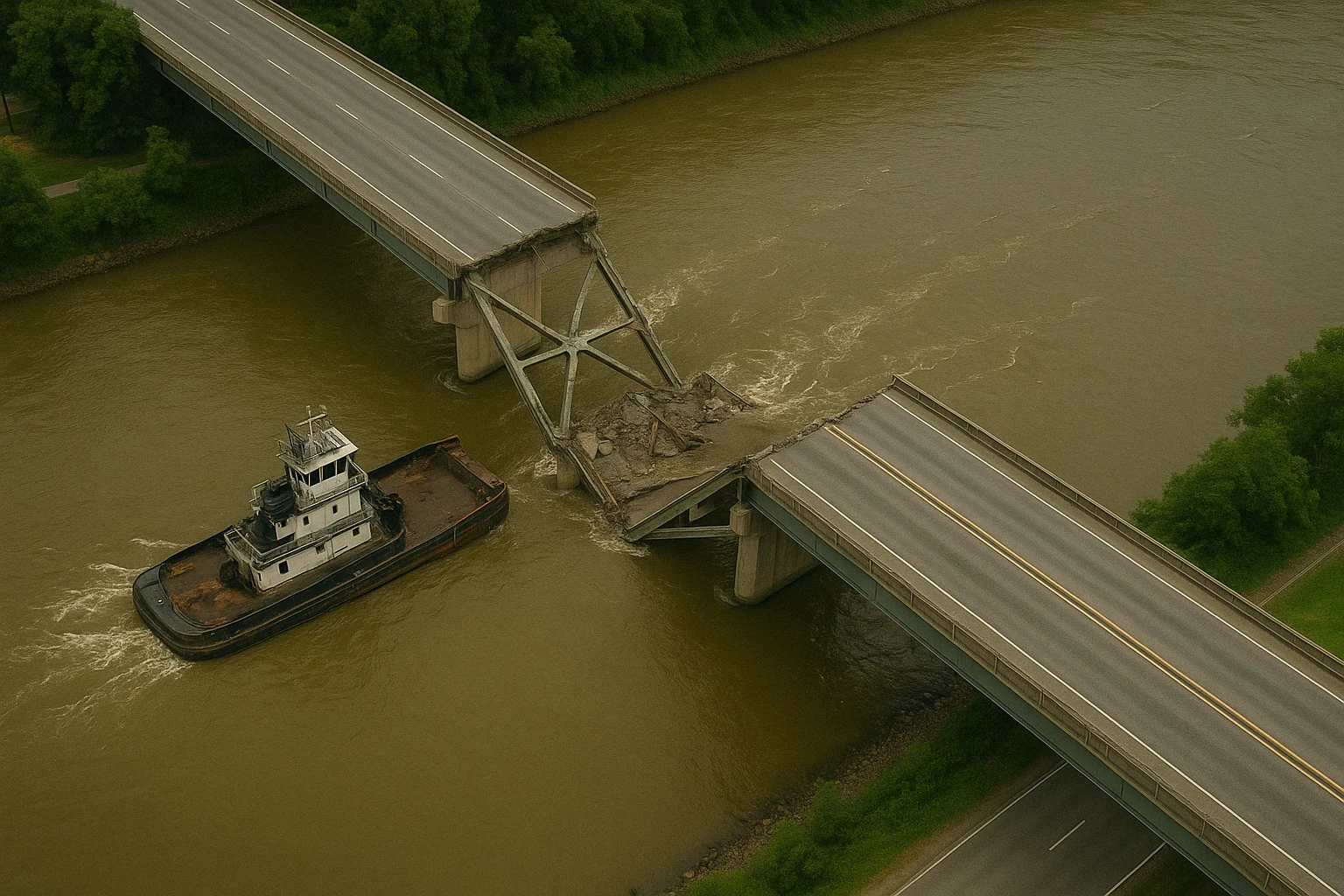
I-40 Bridge Disaster
by: The Calamity Calendar Team
May 26, 2002
A Quiet Morning Shattered
As the sun cast its early light over the Arkansas River on May 26, 2002, the I-40 Bridge stood as a quiet sentinel over the water. Travelers moved across its span, oblivious to the disaster about to unfold. This bridge, a vital artery in the nation’s interstate highway system since the 1960s, was about to be the center of a tragedy that would drag fourteen lives beneath the river's surface.
The day began typically for Captain Joe Dedmon, a seasoned navigator piloting the towboat Robert Y. Love along the bustling waterway. But routine quickly turned into catastrophe. At approximately 7:45 AM, Dedmon—a man whose cognitive abilities were compromised by an undiagnosed medical condition—unexpectedly fell unconscious. This lapse would prove deadly.
The Route and the River
Bridges do more than support—they connect. The I-40 Bridge in Oklahoma connected travelers to their destinations, goods to markets, and people to livelihoods. It passed over the Arkansas River, itself a critical commercial route, bustling with vessels transporting vast quantities of goods. This meeting of vehicular and nautical paths always carried the potential for disaster, a potential that would soon become reality.
The Robert Y. Love, navigating its usual route, experienced a blackout at the most inopportune moment. With Dedmon incapacitated, the vessel—and the two empty barges it propelled—veered towards the bridge’s pier without a hand to steer it away.
Seconds of Tragedy
The impact was seismic. As the barges collided with a bridge pier, a yawning 580-foot section of the highway deck crumbled and fell into the Arkansas River below. The bridge buckled under the force, transforming into a deadly trap for motorists who were unable to halt their journey in time. Vehicles plunged over the edge, metal, and glass shattering as they disappeared into the river's depths.
In those heart-stopping moments, hopes and lives were extinguished. Fourteen souls perished, victims of a disaster as sudden as it was tragic. Others, teetering perilously on the edge or caught in the periphery of disaster, awaited rescue.
Thanks for subscribing!
Racing Against Time
Within minutes, emergency response teams converged on the scene. Divers slipped beneath the water’s surface, desperately searching for survivors. Amidst the chaos, rescuers worked tirelessly, pulling people from precarious perches and submerged vehicles. Each rescuer carried the weight of the scene—the cries of the trapped and injured, the urgency of time slipping away.
Above them, the once-familiar stretch of road now lay eerily silent, a massive gap in the bridge testifying to the morning’s violence. The economic heart of the region took a hit, as did the hearts of those who lost loved ones.
Picking Up the Pieces
The scale of the task ahead was daunting but met with resolve and efficiency. Engineers and construction crews mobilized to rebuild not just a bridge, but the trust invested in it. The cost was steep—around $30 million—but the response was swift. The authorities initiated a ferry service to restore some semblance of normality while reconstruction was underway.
In an impressive display of determination, the new bridge was completed by July 29, 2002, just two months after the disaster. Yet, the scars of that May morning lingered, etched in the minds of survivors and rescuers alike.
Learning and Preventing
Tragedies illuminate vulnerabilities, sparking change in their wake. In the years since the I-40 Bridge disaster, safety protocols have transformed. Improved training and stringent health checks for vessel operators have become the norm. Technological enhancements in navigation and surveillance have woven a tighter safety net, aiming to prevent future catastrophes.
The disaster underscored the fragile interplay of infrastructure and nature. It reminded us of the human element—of the captains, drivers, and passengers who entrust their lives to these constructs each day. And so, the memory of the I-40 tragedy serves as a lasting warning and a catalyst for progress.
The river continues to flow, the new bridge standing firm above it, bearing witness to both history and hope—a testament to resilience in the face of loss. The lessons learned are indelible, a commitment to ensuring that never again should such a crossing lead to oblivion.
Stay in the Loop!
Become a Calamity Insider and get exclusive Calamity Calendar updates delivered straight to your inbox.
Thanks! You're now subscribed.